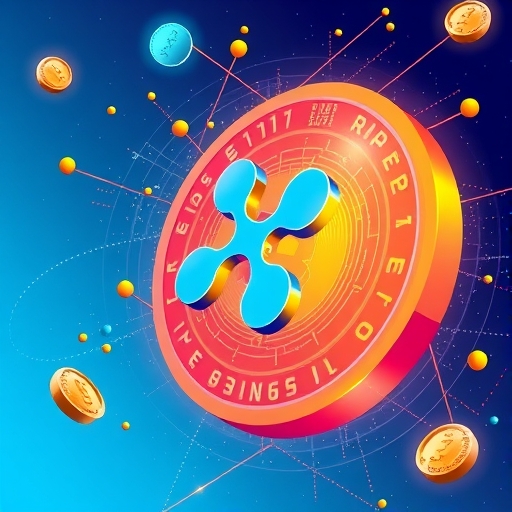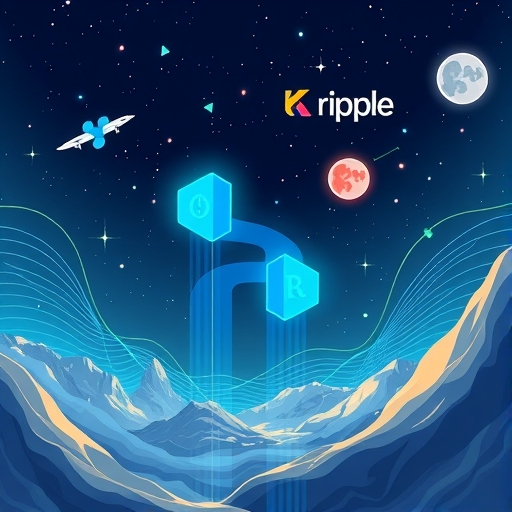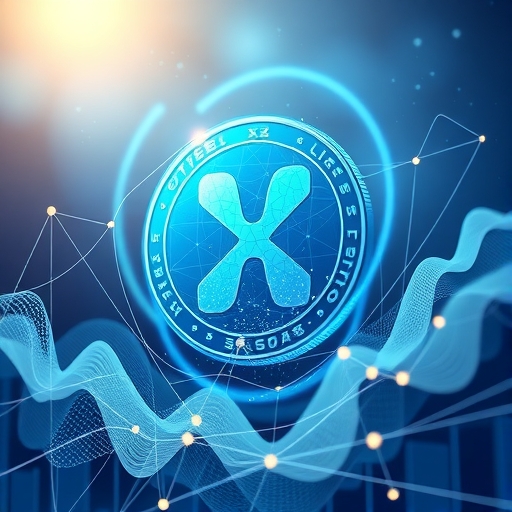XRP’s Dual Trajectory: Unprecedented Utility Meets Market Volatility and Strategic Expansion
Welcome, aspiring investors and seasoned traders, to a deep dive into one of the most intriguing and often debated digital assets in the financial landscape: Ripple’s XRP. We stand at a critical juncture where the lines between traditional finance and the innovative world of decentralized technology are blurring. XRP is not merely a cryptocurrency; it is a digital asset positioned at the forefront of this evolution, driven by a vision to revolutionize global payments and financial infrastructure.
Today, we will unravel the multifaceted narrative of XRP, exploring its accelerating real-world utility, Ripple’s ambitious infrastructure development, and the inherent market volatility that defines its journey. We’ll examine recent pivotal developments, including a Nasdaq-listed company’s integration of XRP, the strategic positioning of the regulated RLUSD stablecoin for institutional finance, and the dramatic price movements that have recently captivated the market. Furthermore, we’ll address crucial warnings from Ripple’s CEO regarding ecosystem security, ensuring you are well-equipped to navigate this complex yet promising arena.
- XRP is designed to facilitate instantaneous cross-border payments.
- Ripple focuses on partnerships with established financial institutions.
- Market volatility presents both challenges and opportunities for investors.
Understanding Ripple’s Vision: Bridging Traditional Finance and Digital Innovation
At its core, Ripple aims to solve a fundamental problem in global finance: the inefficiency, cost, and slowness of cross-border payments. Imagine a world where sending money across continents is as instantaneous and inexpensive as sending an email. This is the vision that fuels Ripple’s efforts, with XRP designed as the ultimate bridge currency in this new financial paradigm. Unlike many cryptocurrencies that primarily focus on decentralization for its own sake, Ripple’s approach is distinctly pragmatic, targeting established financial institutions and corporations.
We often talk about the promise of blockchain technology, but where does it translate into tangible, everyday applications for large enterprises? Ripple’s strategy centers on facilitating real-world utility for XRP, enabling financial institutions to move value globally, on-demand, and with complete transparency. This isn’t about replacing banks, but rather about enhancing their capabilities, making them more efficient and competitive in a rapidly digitizing world. How do they achieve this, and what does it mean for the broader financial infrastructure?
The company leverages its proprietary technology, primarily the XRP Ledger (XRPL), to provide a faster, cheaper, and more reliable alternative to traditional correspondent banking. This focus on institutional adoption sets XRP apart from many other digital assets, positioning it not as a speculative venture alone, but as a foundational element for the next generation of global financial transactions. Our journey into XRP will reveal why this strategic positioning is critical for its long-term potential and how it aims to reshape the flow of money worldwide.

The New Frontier of XRP Utility: Wellgistics Health’s Pioneering Integration
For many, the true measure of a digital asset’s value lies not in its speculative price action, but in its concrete, real-world utility. This is where XRP is beginning to make significant strides. We’ve seen a notable development with Wellgistics Health, a Nasdaq-listed company, reportedly integrating XRP into its core operational framework. This isn’t a mere pilot program or a superficial endorsement; it signifies a robust commitment to leveraging XRP for essential business functions.
Consider the implications: a major enterprise, operating within the stringent regulatory environment of a public company, choosing to embed a digital asset into its financial nervous system. This move by Wellgistics Health showcases a tangible use case for Ripple’s cryptocurrency that extends far beyond speculative trading. They are reportedly adopting XRP for diverse corporate needs, moving it from the periphery of experimental technology to a central operational tool.
This integration is a powerful testament to XRP’s evolving role. It highlights the asset’s capability to serve as a reliable and efficient medium for corporate payments, treasury management, collateralization, and even capital raises. When a company of this stature makes such a move, it sends a strong signal to the market about the maturity and operational readiness of XRP’s utility. What does this mean for the future of enterprise adoption, and how might it inspire other corporations to explore similar integrations?
| Feature | Description |
|---|---|
| Real-world Utility | The effective integration of XRP in corporate environments. |
| Operational Commitments | Wellgistics Health’s adoption of XRP for core operations. |
Beyond Payments: XRP’s Role in Treasury, Collateral, and Capital Raises
Let’s delve deeper into the specific ways Wellgistics Health, and potentially other enterprises, are envisioning XRP’s utility. The traditional narrative around XRP often focuses on its speed and cost-effectiveness for cross-border payments. While this remains a cornerstone of its value proposition, the integration by Wellgistics Health reveals a much broader spectrum of applications. Think about the complexities of corporate treasury management: reconciling global accounts, managing liquidity, and hedging currency risks. XRP’s instantaneous settlement and low fees offer a transformative solution here, drastically reducing operational overhead and improving capital efficiency.
Furthermore, the concept of using XRP as collateral for financial instruments or loans is a powerful step towards unlocking new forms of liquidity in the digital age. Imagine a scenario where traditional assets can be tokenized and collateralized using a rapidly movable, globally accessible digital asset like XRP. This can streamline lending processes and open up new avenues for capital formation, moving beyond the often-slow and cumbersome traditional financial systems.
And then there’s the realm of capital raises. While still nascent for digital assets in a corporate context, the idea of leveraging XRP for fundraising could provide companies with unprecedented flexibility and global reach. It allows for the rapid distribution of value and could potentially attract a wider pool of investors, bypassing some of the traditional gatekeepers and geographical limitations. These multifaceted applications underscore XRP’s potential to become a fundamental operational tool, challenging the perception of cryptocurrencies as purely speculative investments and cementing their place in the evolving global financial infrastructure.

Ripple’s Institutional Stablecoin Strategy: The RLUSD and its Mainstream Push
Beyond the direct utility of XRP, Ripple is making strategic moves to solidify its position within the institutional finance landscape, most notably through its introduction of the RLUSD stablecoin. This isn’t just another stablecoin; it’s meticulously designed to be a regulated backbone for institutional finance, emphasizing compliance and stability. This asset is positioned as a critical bridge for mainstream adoption, providing a reliable, regulated on-ramp for traditional financial entities to engage with digital assets without the volatility associated with cryptocurrencies like XRP.
The strategic partnerships supporting RLUSD are particularly telling. Its custody by a major player like BNY Mellon, one of the world’s largest custodian banks, instills a high degree of confidence and legitimacy. Furthermore, its compliance with NYDFS (New York Department of Financial Services) regulation signals a commitment to operating within established legal frameworks, a crucial factor for institutional trust and widespread adoption. We’ve even seen speculation linking its internal settlement testing to major entities like Bank of America, which, if confirmed, would represent a colossal leap towards integrating digital assets into core banking operations.
This initiative demonstrates Ripple’s understanding that for digital assets to truly permeate traditional finance, they must meet the stringent requirements of regulation, security, and trust that institutions demand. The RLUSD is not just about payments; it’s about building a robust, compliant digital asset ecosystem that can facilitate everything from interbank settlements to the tokenization of complex financial instruments. It is a calculated move to capture a significant share of the burgeoning institutional digital asset market, fundamentally reshaping how value is moved and held within the global financial infrastructure.
Unlocking New Capabilities: The XRP Ledger’s Expansion with Wormhole and EVM
The strength of XRP is intrinsically linked to the continuous evolution and expansion of its underlying technology: the XRP Ledger (XRPL). Ripple understands that for XRPL to remain competitive and relevant in a rapidly advancing blockchain ecosystem, it must foster interoperability and expand its functional capabilities. This foresight is evident in recent key integrations and developments, most notably with Wormhole and the ongoing creation of an EVM sidechain.
The integration of Wormhole, a leading interoperability platform, is a game-changer for XRPL. It facilitates seamless cross-chain finance, allowing assets and data to flow between XRPL and other major blockchain networks. Why is this important? In a fragmented digital asset landscape, interoperability is paramount for liquidity and utility. It means XRP, or assets tokenized on XRPL, can interact with decentralized applications (dApps) and liquidity pools on other chains, significantly broadening XRPL’s reach and enhancing its overall value proposition.
Equally significant is the development of an XRPL EVM sidechain. The Ethereum Virtual Machine (EVM) is the computational engine behind Ethereum, and by creating an EVM-compatible sidechain, XRPL is opening its doors to a vast ecosystem of developers and existing dApps. This move is crucial for fostering institutional DeFi (Decentralized Finance) and the tokenization of Real-World Assets (RWA). Imagine traditional financial instruments, real estate, or commodities being represented as tokens on the XRPL, accessible and tradable within a compliant and efficient framework. This technological advancement positions XRPL as a versatile platform not just for payments, but for a wide array of sophisticated financial applications, paving the way for a truly integrated digital economy.
Navigating the Storm: XRP’s Recent Price Surge and the Sudden Market Correction
While fundamental utility and technological advancements are critical for long-term growth, the immediate reality for many investors often centers on market performance and volatility. XRP recently provided a stark reminder of the dynamic nature of cryptocurrency markets, achieving a fresh all-time high that surpassed its 2018 peak, reaching approximately $3.65. This surge propelled XRP’s market capitalization to an astonishing $207 billion, briefly placing it among the top-tier digital assets by valuation. For many long-term holders, this was a moment of vindication, celebrating years of patience and belief in the asset’s potential.
What drives such parabolic moves? Often, it’s a confluence of positive news, increasing investor sentiment, and perhaps a degree of speculative fervor. The news of corporate integrations, stablecoin developments, and technological upgrades undoubtedly contributed to this optimistic outlook. As new investors entered the market, driven by FOMO (Fear Of Missing Out), buying pressure intensified, creating a positive feedback loop that pushed prices higher and higher. It’s a classic example of how positive narratives can ignite significant price rallies in the often-exuberant world of digital assets.
However, as we know, what goes up can come down, often with surprising speed in crypto markets. The joy of a new all-time high was swiftly followed by a dramatic market correction, demonstrating the inherent market volatility of even established cryptocurrencies. This roller coaster ride is a critical learning experience for any investor, highlighting the importance of understanding not just what drives prices up, but also what triggers sharp downturns.

The Power of Whales: Decoding the XRP Price Crash on Upbit and its Aftermath
The exhilarating ascent of XRP to its new all-time high was abruptly halted by an event that underscores the significant influence of large market participants, often referred to as “whales.” A rapid 15% price crash occurred due to a substantial whale offload on the Upbit exchange, a prominent South Korean platform. This single transaction, involving a staggering 75 million XRP, was enough to trigger a cascading effect across the market, leading to the liquidation of an estimated $90 million in long positions.
To understand the mechanics, imagine a large dam holding back a reservoir of water. When a significant gate opens, the water rushes out, creating a powerful current. Similarly, when a single entity unloads such a massive quantity of a digital asset onto an exchange, it creates immense selling pressure. This sudden influx of supply, unmet by immediate buying demand at the current price, forces the price down. As the price drops, it hits the liquidation levels of leveraged long positions – traders who borrowed funds to bet on higher prices. When their collateral can no longer cover their losses, their positions are automatically closed, adding even more selling pressure to the market, a phenomenon known as a long squeeze.
This event serves as a critical lesson in market dynamics: even strong fundamental narratives can be temporarily overshadowed by the actions of large market participants. It highlights the importance of understanding order books, liquidity, and the potential impact of sudden supply shocks. For new investors, this is a stark reminder that while the promise of digital assets is immense, so too are the risks, and market volatility remains a constant companion on this journey. It emphasizes the need for risk management and a clear understanding of potential downside scenarios, even when sentiment is overwhelmingly positive.
Fortifying the Ecosystem: Battling Scams and Ensuring Investor Security
As the digital asset space continues to grow and attract more participants, it unfortunately also becomes a fertile ground for malicious actors. Ripple CEO Brad Garlinghouse has recently issued a critical warning to XRP investors, highlighting a proliferation of sophisticated scams. These fraudulent schemes often impersonate official Ripple entities or even individuals like Garlinghouse himself, particularly on platforms like YouTube, enticing unsuspecting investors with fake giveaways, airdrops, or investment opportunities.
This is a serious concern for any digital asset ecosystem. Scammers prey on the excitement and sometimes the lack of technical understanding among new investors. They often use tactics like urging users to send funds to a specific address to receive a larger return, or providing links to phishing websites designed to steal private keys or personal information. Such incidents not only result in financial losses for individuals but can also erode trust in the broader digital asset community. What steps can you take to protect yourself from these predatory practices?
The advice from Ripple’s leadership is unequivocal: exercise extreme vigilance. Always verify the source of information, especially anything requesting you send digital assets or reveal sensitive personal data. Official announcements from Ripple will always come through their verified channels, not through random social media posts or unsolicited messages. This warning underscores Ripple’s commitment to not only advancing technology but also to safeguarding its community, recognizing that a secure and trustworthy environment is paramount for sustainable growth and long-term adoption of XRP and the broader digital assets space.
Tracking Growth: User Adoption Milestones on the XRP Ledger and Future Prospects
Despite the market volatility and ongoing security challenges, the underlying growth of the XRP Ledger (XRPL) ecosystem continues to demonstrate robust momentum. The XRPL recently reached a significant milestone, surpassing 7.2 million wallets. This figure is not just a number; it represents a thriving community and a clear indication of sustained user adoption and network interest. Each new wallet signifies an individual or entity actively engaging with the XRP Ledger, either for transactions, holding assets, or participating in the growing array of applications built on the platform.
Looking at user growth metrics provides valuable insights into the health and trajectory of a blockchain network. A steadily increasing wallet count suggests that the network is attracting new users and finding new applications, extending its reach and utility. This expansion is crucial for network effects, where the value of a network increases disproportionately with each new participant. It speaks to the effectiveness of Ripple’s long-term strategy of building a foundational financial infrastructure that appeals to both institutional players and individual users.
However, an astute observer will also note that while growth is robust, the pace of new wallet creation is showing signs of deceleration since mid-2024. This isn’t necessarily a negative signal but could indicate a maturing market entry phase. It suggests that the initial wave of early adopters might be plateauing, and future growth may come from deeper integration into existing systems or from broader public education rather than rapid speculative influxes. Understanding these nuances in user growth patterns helps us paint a more accurate picture of XRPL’s ongoing development and its potential for future expansion within the broader landscape of digital assets.
The Path Forward: XRP’s Position in the Evolving Digital Asset Landscape
As we conclude our comprehensive analysis, it becomes clear that XRP continues to demonstrate its relevance and considerable potential within the rapidly evolving digital asset landscape. Its journey is characterized by a dual trajectory: significant strides in concrete real-world utility for enterprises like Wellgistics Health, coupled with ambitious strategic advancements in its underlying XRP Ledger (XRPL) infrastructure. The introduction of the regulated RLUSD stablecoin and the expansion of XRPL’s capabilities through integrations like Wormhole and the EVM sidechain firmly position Ripple at the forefront of building the next generation of global financial infrastructure.
However, the path forward is not without its challenges. The persistent market volatility, as vividly illustrated by the recent price surge and subsequent sharp correction due to whale activity, reminds us of the inherent risks in this nascent market. Moreover, the critical need to combat sophisticated scams, as highlighted by Ripple CEO Brad Garlinghouse, underscores the ongoing responsibility to safeguard investors and maintain trust in the ecosystem. These challenges are not unique to XRP but are symptomatic of the broader digital asset space as it matures.
Despite these hurdles, Ripple’s unwavering commitment to institutional integration and the steady expansion of the XRP Ledger’s user base position XRP as a key player in shaping the future of global financial transactions. It is moving firmly towards widespread, real-world adoption, extending its utility far beyond mere speculative narratives. For both new investors and seasoned traders, understanding these multifaceted dynamics is essential. XRP is not just a digital asset; it is a testament to the transformative power of blockchain technology in finance, poised to revolutionize how value is moved, managed, and created across the globe.
what is ripple xrpFAQ
Q:What is Ripple XRP?
A:Ripple XRP is a digital asset designed to facilitate fast and cost-effective cross-border transactions.
Q:How does XRP work with financial institutions?
A:XRP serves as a bridge currency, enabling financial institutions to transfer value quickly and efficiently.
Q:What are the risks of investing in XRP?
A:The risks include price volatility, market manipulation by whales, and potential regulatory changes.
